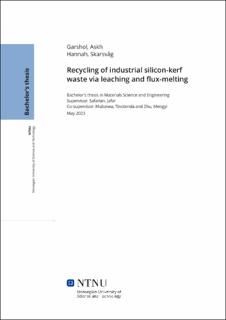| dc.contributor.advisor | Safarian, Jafar | |
| dc.contributor.advisor | Mubaiwa, Tinotenda | |
| dc.contributor.advisor | Zhu, Mengyi | |
| dc.contributor.author | Garshol, Askh Kano | |
| dc.contributor.author | Hannah, Skarsvåg | |
| dc.date.accessioned | 2023-07-18T17:20:39Z | |
| dc.date.available | 2023-07-18T17:20:39Z | |
| dc.date.issued | 2023 | |
| dc.identifier | no.ntnu:inspera:146717571:150648189 | |
| dc.identifier.uri | https://hdl.handle.net/11250/3080028 | |
| dc.description.abstract | Produksjonen av solar grade silisium oblater som brukes i solcelleproduksjon er en lang og kompleks prosess som resultater i at 50% av rent silisium blir kastet vekk etter kutte prossesen. Dette har vært et problem som har påvirket og plaget industrien i mange år, og ulike metoder og patenter for resirkulering har blitt fremmet for å prøve å bekjempe dette. REC Solar Norway er en bedrift som har kommet opp med ulike prosesser og metoder som brukes for å produsere silisum, som for eksempel ELKEM prosessen. Formålet med forskningen og laboratoriearbeidet var å bruke silisiumkerf fra indsutriavfallet og for å fjerne de ulike urenheter gjennom pyrometallurgiske og hydrometallurgiske behandlinger for å produsere solar grade siliusium. Syreutlutning var den første trinnet i foredlingsprossessen for å fjerne metalliske urenheter mens en induksjonsovn ble brukt til å smelte silisiumkerfen etter utluting og for å fjerne urenhter som ble ikke fjernet i utlutnings prossesen. To prøver ble smeltet uten tilsetningstoffer mens de andre prøvene ble smeltet sammen med CaO-SiO2 slag og FBR Si. Karakteriseringen og analysen av prøvene ble utført ved bruk av elektronmikroskopi og massespektroskopi. I samsvar med de teoretiske aspektene ved dette forsøket, var resultatene veldig lovende. GD-MS resultatene pekte imot at det ble produsert solar grade silisium, men et ekstra foredlingstrinn som direction solidification er nødvendig, samt ytterligere optimalisering av utlutnings og smelte prossesen for å produsere solar grade silisium. | |
| dc.description.abstract | The production of solar grade silicon wafers used in solar cell production is a long and complex process that results in 50% of pure silicon being wasted. This volume of waste has been a problem that has impacted the industry for many years now and different methods of recycling have been brought forward and patented to try and combat this high volume of silicon waste. REC Solar Norway is a pioneer when it comes to different process and methods used to produce silicon as the ELKEM process. The purpose of this research and lab work was to use silicon kerf from industry waste and remove the impurities within the silicon kerf through pyrometallurgical and hydrometallurgical treatments and produce solar grade silicon. Acid leaching was used as the first step in the refinement process to remove metallic impurities while an induction furnace was used to melt the silicon kerf after leaching and to further remove impurities that the acid leaching could not remove. Two samples were melted without any additives while other samples were melted along CaO-SiO2 slag and FBR Si. The characterization and analysis of the samples were carried out using electron microscopy and mass spectroscopy. The results from the refinement process were very promising and aligned with the theoretical aspects of this experiment. The GD-MS results pointed towards solar grade silicon being produced however an additional refinement step such as directional melting is needed, as well as further optimizing the leaching and melting process in order to produce solar grade silicon. | |
| dc.language | eng | |
| dc.publisher | NTNU | |
| dc.title | Recycling of industrial silicon-kerf waste via leaching and flux-melting. | |
| dc.type | Bachelor thesis | |
